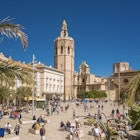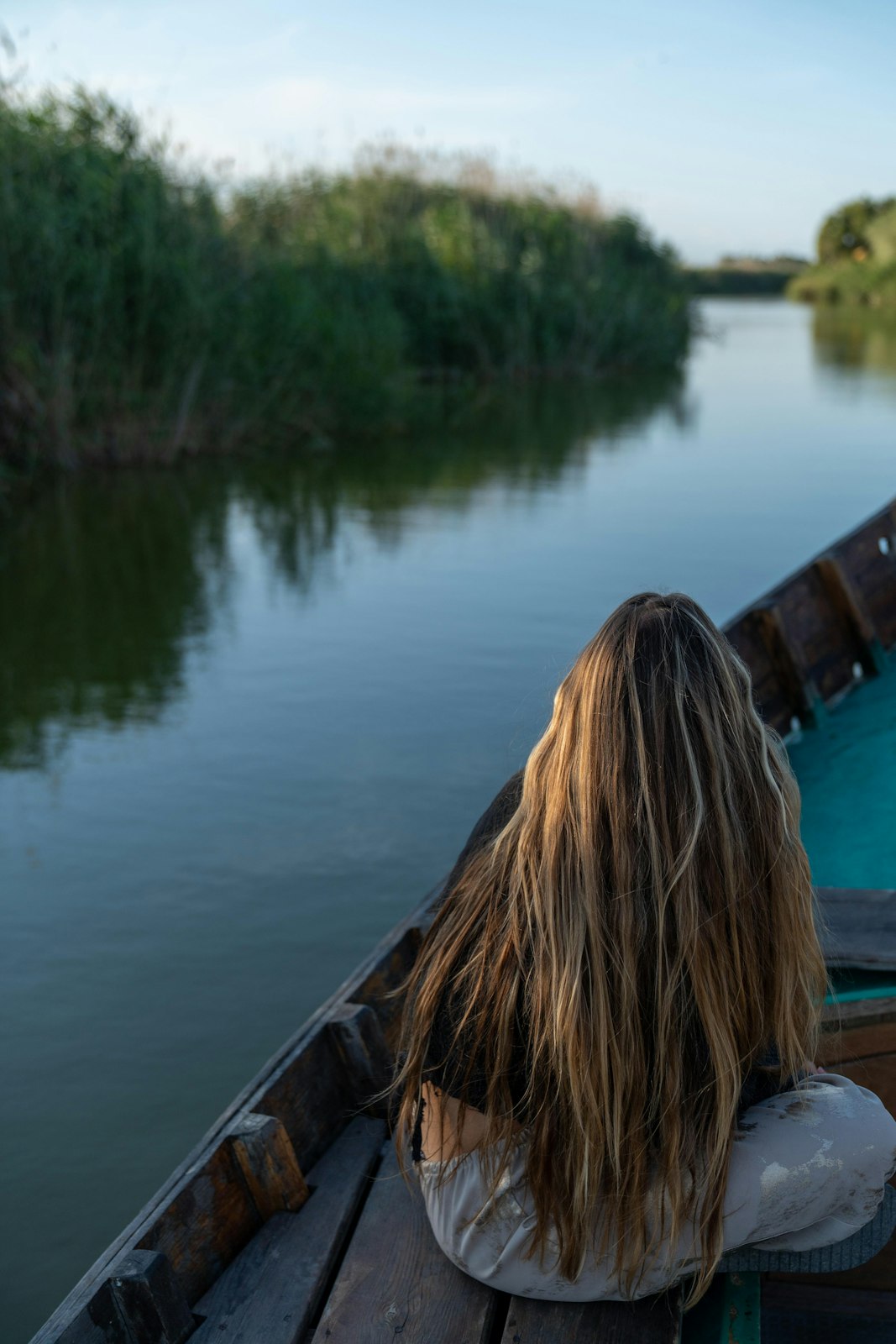
Valencia’s stunning parks and outdoor spaces
Sponsored by
- placement: logo
- path: articles/header-badge-logo
- possible size: [1, 1],
- targeting:
{ "url": "valencia-city-parks" }
Aug 2, 2024 • 5 min read

Valencia's outdoor spaces – like Parque Central – inspire locals and visitors alike to enjoy the great outdoors.
Valencia has a sky that's almost always bright blue: no wonder everyone would rather be outside. Life happens in the street in Spain's third-largest city, whether that's catching up with friends on sunny terraces over a caña or sipping mojitos with toes plunged into the golden sand.
Come to Valencia to marvel at modernist architecture and Gothic monuments and when it's time to unplug, head to the secluded beach in a thriving natural park, wade a stand up paddleboard into the calm ocean, or roll out a yoga mat in one of the lush city parks. Further afield there are mountains to explore and leafy bicycle paths to whizz along.
Whether it's elegant squares or natural beauty, Valencia's outdoor spaces inspire people to enjoy the great outdoors.




Jardin del Turia
Draped across the city like a winner's sash, Jardin del Turia is a 5.6-mile-long green lung. It's planted in the former riverbed of the Río Turia, which was diverted after a devastating flood in 1957. Today, it's the largest urban park in Spain. It's speckled with lemon trees, grassy meadows and cafés serving chilled horchata under rubber trees. Some roped-off areas might look overgrown; these are wild sections, left unkempt to encourage biodiversity. Threaded through the plants are running routes and bike paths, while yoga classes take place under the shade of palm trees. Walk along the paths to reach cultural hubs, like the grand music venue Palau de la Música and the otherworldly Ciudad de las Artes y las Ciencias.


Valencia city beaches
Valencia's most popular beach, Playa El Cabañal is a lively stretch of butter-yellow sand backed by the old fisherman's quarter. Begin by exploring the barrio's character-filled tiled houses and then pop into the local market, Mercat Municipal del Cabanyal for some field-fresh peaches before making tracks to the seaside. Not into sunbathing? Book one of the volleyball courts for free on Playa de la Malvarrosa for you and up to eight friends with the local school BeachBol.
A wealth of water activities await just offshore from all of Valencia’s beaches. From sunset cruises and catamaran sailing to jet skis, windsurfing and paddle boarding, there’s something for every kind of nautical adventurer.
Less than 7 miles from the city is Albufera, and El Saler Beach. Blake Horn for Lonely Planet
La Devesa
Away from the well-trodden path, this secluded beach just south of Valencia is a sustainability and rewilding success story. The coastline of La Devesa was nearly set to be redeveloped, but thankfully the project was scrapped in favor of keeping the beach natural. The shrub-covered dunes have been reinstated, and now the wild coastline is only accessible by foot. Take the number 25 bus from Porta de la Mar to Embarcador de l'Albufera, then it's a pleasant 20-minute walk past pine trees and butterflies to reach the hidden sands dotted with shells. Pack a picnic: there are no beach bars shaking up cocktails here. It's peaceful, undeveloped, and totally relaxing.
Finish with a visit to nearby La Albufera for the region’s famous paella – Bon Aire serves their house special (snails optional) on a terrace beside the rice paddies, or you can escape the elements in the bright and airy Restaurant El Redoli. For a great boat tour of l’Albufera, coupled with delicious paella, look for Nou Racó – it offers traditional flavors with avant garde presentation.




Jardín Botánico
Hidden in a quiet corner of the city center, Jardín Botánico has a fascinating history with roots that stretch back to the 16th century; it was relocated to its current location in 1802. Throughout the 19th century botanical classes took place in this leafy oasis, before it sadly fell out of use. A ten-year recovery project, finished in 2000, restored the old features and added new sights, like the grand orchid and carnivorous plant glasshouse. Now it's a restorative haven, ideal for morning walks or balmy evening strolls (it's open until 8pm). Keep an eye on its website for dreamy activities among the flowers.


Plaza de la Virgen
Graceful Plaza de la Virgen is one of Valencia's most atmospheric squares, and it’s steeped in history. There has been a square of sorts here since Roman times, and thousands of years later people still gather here to socialize under the clear sky. In the center, a reclining figure in the fountain represents the Río Turia, and each woman surrounding him represents the eight irrigation canals that watered the surrounding farmland. For a better view, go to the rooftop of Hotel Palacio Vallier (there's a €10 minimum spend per person). Up here, there's an eagle-eye perspective over the shell-pink basilica and the cathedral.




Bioparc and Oceanográfic
Opened in 2008, Bioparc is an enormous zoo found at the western end of Jardin del Turia. This huge park has been cleverly designed to feel more immersive: traditional fences and cages are replaced with streams, rocks and lakes. Recreated habitats include the African savannah with rhinos and antelopes, and the Kenyan wetland with crocodiles and hippos. Even the café is set in a round hut-inspired building, with giraffes ambling past the terrace. Over in the Madagascar zone, lemurs with long, bouncy tails scuttle along fences and between the ankles of visitors. Keep an eye out for Makena, the first baby elephant ever born in Valencia.
Spain's most famous aquarium, Oceanográfic, is the southernmost building of the Ciudad de las Artes y las Ciencias. The sharks, complete with tunnel, are an obvious favorite, while a series of beautiful tanks present species from temperate, Mediterranean, Red Sea and tropical zones. Out of the water, An aviary presents wetland birds, while polar regions feature penguins, and there are seals, sea lions and walruses, too.




Parque Central
Russafa is one of Valencia's most culture-packed barrios, and in 2019 a new park was designed to bring some greenery to this vibrant area. Parque Central is a multi-faceted leafy space with peaceful water features, native flora and modern installations; it's perfect for picnics and taking a breather after action-packed sightseeing. In the height of summer, children love dashing and squealing through the interactive fountains called Estanque de la Panderola while families celebrate birthdays on picnic benches in the shade. In the center, a walkway shaded by a canopy of pink bougainvillea leads to a large grassy expanse and a flower garden interspersed with trickling pools. Pick up some seasonal fruit and other local delicacies from Ruzafa Market en route and spread out a blanket next to the roses for a blissfully unhurried afternoon.
From our sponsors: Visit the official tourism website of Valencia to start planning your trip today.
Sponsored by Visit Valencia
As a travel entertainment and inspirational media outlet, we sometimes incorporate brand sponsors into our efforts. This activity is clearly labeled across our platforms.
This story was crafted collaboratively between Visit Valencia and Lonely Planet. Both parties provided research and curated content to produce this story. We disclose when information isn’t ours.
With sponsored content, both Lonely Planet and our brand partners have specific responsibilities:
Brand partner
Determines the concept, provides briefing, research material, and may provide feedback.
Lonely Planet
We provide expertise, firsthand insights, and verify with third-party sources when needed.
- placement: fullWidth
- path: articles/bottom
- possible size: [970, 250], [970, 90], [728, 90], [300, 250], [320, 50], [1, 1],
- targeting:
{ "url": "valencia-city-parks" }
Explore related stories


 Art and CultureCopy my trip: An unforgettable family trip to Spain with Elsewhere by Lonely Planet
Art and CultureCopy my trip: An unforgettable family trip to Spain with Elsewhere by Lonely PlanetNov 19, 2024 • 4 min read



 Budget TravelEverything you need to know about visiting Barcelona on a budget
Budget TravelEverything you need to know about visiting Barcelona on a budgetOct 23, 2024 • 6 min read











